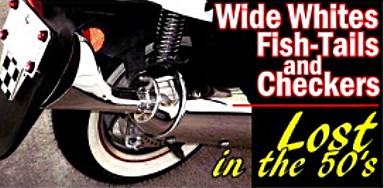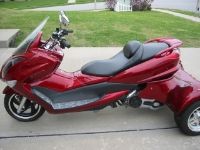Post by oldchopperguy on Apr 17, 2013 0:23:35 GMT -5
Anyone with a Chinese scoot with the dual-piston rear caliper disk-brake may find this will save them a LOT of irritation if they suffer the no-brake, "limp-lever" syndrome I experienced. 
I've made several posts (deleted the last one) concerning this phenomenon since my rear brake went bad while applying it, to hold the rear wheel while replacing the valve stem. The lever began to apply braking, then, it just went to the handlebar with no resistance.
I found the handlebar master-cylinder was really trash, and replaced it, back-flushed and re-filled the fluid, but no difference. Still no brake or lever resistance.
I then replaced the wheel-cylinder/caliper assembly. But, BEFORE re-filling and bleeding, I examined the OLD caliper. The pistons were extended FAR beyond what looked "normal".
I then placed the new caliper over the disk, and found there was a full 1/8"+ "daylight" BEFORE the pad would contact the disk.
So... I took the inner pad from the old caliper and ground off all the friction material with a disk-grinder. I then placed it BETWEEN the NEW inner (moving) pad and the pistons in the NEW caliper, and installed it.
The "spacer" made from the old steel pad-backer placed the new caliper's moving inner pad right where it should be, with minimal space between it and the disk.
I back-flushed and filled the fluid as/per Alleyoop's great video instructions, and... BINGO! I once again have a proper rear brake!
Apparently, these dual-piston calipers are made with enough clearance to acommodate a full 1/4" thick disk. My scoot has about a 1/8" thick disk. This forces the pistons in the caliper near their EXTREME limit of travel, JUST TO PUSH THE PAD AGAINST THE DISK.
Add a fraction of an inch of pad wear, and suddenly the pistons are fully-extended, and all braking action ceases.
So if you have a brake similar to mine, and you have a good amount of wear on the brakes, you may experience the "limp-lever" no-brake syndrome at any time. Some scoots have these brake-calipers on the FRONT too... THAT could be REAL trouble.
It seems that placing a spacer (easiest way is to use the steel backer from an old pad) corrects the extra "slop" in the caliper.
I've messed with this rear brake now for over a month of spare time, and learned a whole new, foul "vocabulary" definitely NOT Chinese... HeHeHe... in the process... LOL!
A caliper with a fat quarter-inch between pads is just NOT good on a skinny eighth-inch disk. So much for Chinese "one-size-fits-everything" engineering...
I sincerely hope this will help any riders out there who may encounter the same problem. It's not common... apparently I use my rear brake more than average. We have a lot of loose gravel, oil, mud, dirt, always-wet angled railroad track crossings, etc. around here, and I truly HATE locking up the FRONT wheel on slippery surfaces... EEEWWWW! Shirvels me like a spider on a hot skillet! So I probably DO use my rear brake more than some riders. However, my old pads were only moderately worn. Not even HALF used up.
But... THAT small amount of wear allowed the caliper-pistons to go past their limits, ending all braking action.
Live and learn...
Leo (puttin' Lil'Bubba back together) in Texas

I've made several posts (deleted the last one) concerning this phenomenon since my rear brake went bad while applying it, to hold the rear wheel while replacing the valve stem. The lever began to apply braking, then, it just went to the handlebar with no resistance.
I found the handlebar master-cylinder was really trash, and replaced it, back-flushed and re-filled the fluid, but no difference. Still no brake or lever resistance.
I then replaced the wheel-cylinder/caliper assembly. But, BEFORE re-filling and bleeding, I examined the OLD caliper. The pistons were extended FAR beyond what looked "normal".
I then placed the new caliper over the disk, and found there was a full 1/8"+ "daylight" BEFORE the pad would contact the disk.
So... I took the inner pad from the old caliper and ground off all the friction material with a disk-grinder. I then placed it BETWEEN the NEW inner (moving) pad and the pistons in the NEW caliper, and installed it.
The "spacer" made from the old steel pad-backer placed the new caliper's moving inner pad right where it should be, with minimal space between it and the disk.
I back-flushed and filled the fluid as/per Alleyoop's great video instructions, and... BINGO! I once again have a proper rear brake!
Apparently, these dual-piston calipers are made with enough clearance to acommodate a full 1/4" thick disk. My scoot has about a 1/8" thick disk. This forces the pistons in the caliper near their EXTREME limit of travel, JUST TO PUSH THE PAD AGAINST THE DISK.
Add a fraction of an inch of pad wear, and suddenly the pistons are fully-extended, and all braking action ceases.
So if you have a brake similar to mine, and you have a good amount of wear on the brakes, you may experience the "limp-lever" no-brake syndrome at any time. Some scoots have these brake-calipers on the FRONT too... THAT could be REAL trouble.
It seems that placing a spacer (easiest way is to use the steel backer from an old pad) corrects the extra "slop" in the caliper.
I've messed with this rear brake now for over a month of spare time, and learned a whole new, foul "vocabulary" definitely NOT Chinese... HeHeHe... in the process... LOL!
A caliper with a fat quarter-inch between pads is just NOT good on a skinny eighth-inch disk. So much for Chinese "one-size-fits-everything" engineering...
I sincerely hope this will help any riders out there who may encounter the same problem. It's not common... apparently I use my rear brake more than average. We have a lot of loose gravel, oil, mud, dirt, always-wet angled railroad track crossings, etc. around here, and I truly HATE locking up the FRONT wheel on slippery surfaces... EEEWWWW! Shirvels me like a spider on a hot skillet! So I probably DO use my rear brake more than some riders. However, my old pads were only moderately worn. Not even HALF used up.
But... THAT small amount of wear allowed the caliper-pistons to go past their limits, ending all braking action.
Live and learn...
Leo (puttin' Lil'Bubba back together) in Texas







 ..BAD TO THE BONE..
..BAD TO THE BONE..








